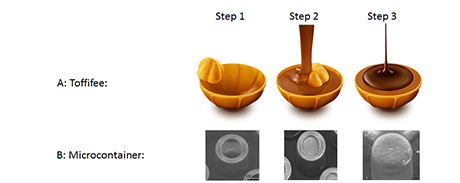Overall goal:
To explore micrometer sized containers for oral drug delivery to:
- Protect drugs
- Control release kinetics
- Enable adhesion for enhanced adsorption
- Realize unidirectional release
- Combined/sequential release
In IDUN Drug we are fabricating and investigating micrometer sized containers for their potential in oral drug delivery. Different mechanisms for fabrication, filling and closing the cavity of the microcontainers are studied, as well as the potential to orally deliver different drugs such as insulin and vaccines. The aim is to increase the oral bioavailability of these unstable drugs by stabilizing and protecting them through the mouth and stomach and making them available only in the small intestine where the drugs are absorbed. The ultimate goal is to avoid the safety issues, discomfort and inconvenience of injections.
Principle of the microcontainers:

The process of filling and coating the microcontainers resembles the process of a Toffifee chocolate
The microcontainers are fabricated by different nano- and micro fabrication techniques followed by loading the microcontainers with medicine which is performed in a similar way as when making a Toffifee chocolate: Starting with (step 1) an empty shell (A: caramel or B: polymer), then (step 2) where the filling is added (A: nut and nougat, B: medicine), and in the end (step 3) where the lid is attached (A: chocolate, B: polymer). A lot of research is going on in these three steps: Step 1: Different fabrication techniques for fabricating the polymer shell are explored (photolithography, embossing and 3D printing). Moreover, different shapes and sizes of the microcontainers are investigated for finding the optimal morphology for the oral drug delivery system. For preparing to step 2 various formulations of medicine and polymer are investigated (spray dryer), and several techniques for filling the microcontainers with medicine are being studied (CO2 impregnation and punching). For step 3, different types and thicknesses of lids and other coatings are being tested (spray coater).
For testing the microcontainers a range of different in vitro and in vivo methods and techniques are used:
A texture analyzer is used to determine the adhesion of microcontainers to the tissue present in the intestine. Different shapes, surface structures and coatings are compared in order to determine how tight the microcontainers adhere to the tissue and what kind of variables influence the adhesion. For further testing the adhesion of the microcontainers models have been set up to investigate the mucoadhesion in ex vivo models. For testing how fast and efficient the medicine is released from the microcontainers release studies are performed using a micro dissolution system. Also, Raman spectroscopy is used to investigate how the drug is distributed inside the containers. For exploring the microcontainers at different stages (empty, filled and with lid) SEM and micro-CT (micro-computed tomography) are used and cryo-TEM is used to investigate the nanoparticles filled into the microcontainers.
The performance of the microcontainers as a drug delivery system is investigated using different model system such as cell cultures, and animal studies using mice and rats.